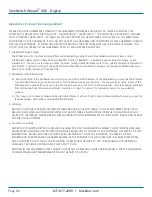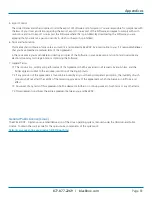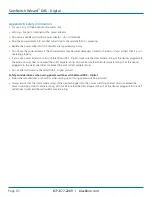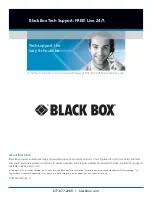
Appendices
877-877-2269 | blackbox.com
Page 79
Function keys
F1
|
F2
|
F3
|
F4
|
F5
|
F6
|
F7
|
F8
|
F9
|
F10
|
F11
|
F12
Creating macro sequences
Hot key macro sequences can be up to 256 characters long. All keys are assumed to be released at the end of a line, however,
you can also determine that a key is pressed and released within a sequence. Any of the following three examples will send a
command that emulates and a press and release of the Scroll Lock key:
+SCROLL-SCROLL
+-SCROLL
+SCROLL-
Example:
+--1+ENTER
Press and release scroll twice, press 1 then enter then release all keys (equivalent definition is +SCROLL-SCROLL-
1+ENTER-1-ENTER)
Using abbreviations
To reduce the length of the key definitions, any unique abbreviation for a key can be used. For example: “scroll”, “scr” and even
“sc” all provide an identifiable match for “ScrollLock” whereas “en” could not be used because it might mean “Enter” or “End”
(“ent” would be suitable for “Enter”).
Note: Hotkey sequences and abbreviations are not case sensitive.
For information about where to enter these codes, please see the sections
or
Port Direct
Port Direct is totally transparent communication system that allows supporting KVM switches and remote access devices to
communicate with each other. Using the keyboard connections that link each device, Port Direct allows:
• A controlling device to provide address details of the required port, the user’s name and access rights, mouse calibration and
video mode information.
• A controlled device to confirm the address and other details of the current port.
Such communication simplifies both the configuration and selection of systems, especially within a complex cascade structure.
Port Direct provides excellent security control to prevent users from accessing systems for which they do not access rights
(‘sideways movement’) because each unit is fully informed of each user’s precise access rights.
Port/host addressing using Port Direct
When adding new computers to the Hosts list, the option ‘
Add entry for unrecognised host’
is provided to automatically add new
entries if a port is visited that does not already have a matching host entry. This is a useful option for simple KVM switch
configurations, but should be used with care when complex cascades of switches are being used as it may lead to more host
entries being added than are strictly necessary.
Additionally, you can specify the port number of the required system using the same format as if controlling the KVM switch
directly. Port numbers MUST be entered within square brackets and can be specified to a maximum of four cascaded levels.
Examples
[16]
selects port 16 and is equivalent to the hotkey sequence
+CTRL+ALT+–1+6
[4105]
selects port 5 on a KVM switch that is cascaded through port group 41




















